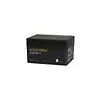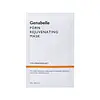What's inside
What's inside
 Key Ingredients
Key Ingredients

 Benefits
Benefits

 Concerns
Concerns

 Ingredients Side-by-side
Ingredients Side-by-side

Water
Skin ConditioningGlycerin
HumectantMethylpropanediol
SolventMethyl Gluceth-20
HumectantDipropylene Glycol
HumectantPanthenol
Skin ConditioningCaprylic/Capric Triglyceride
MaskingPolyglyceryl-4 Caprate
Emulsifying1,2-Hexanediol
Skin ConditioningButylene Glycol
HumectantEthylhexylglycerin
Skin ConditioningPanax Ginseng Root Extract
EmollientSodium Dna
Skin ConditioningSorbitan Isostearate
EmulsifyingSorbitan Sesquioleate
EmulsifyingCetearyl Olivate
Sorbitan Olivate
EmulsifyingAllantoin
Skin ConditioningHydroxyacetophenone
AntioxidantAcrylates/C10-30 Alkyl Acrylate Crosspolymer
Emulsion StabilisingArginine
MaskingXanthan Gum
EmulsifyingSodium Polyacrylate
AbsorbentCaprylyl Glycol
EmollientDisodium EDTA
Aronia Melanocarpa Fruit Extract
Skin ConditioningPentylene Glycol
Skin ConditioningApium Graveolens Extract
Skin ConditioningBrasenia Schreberi Leaf Extract
Skin ConditioningOcimum Basilicum Seed Extract
AntioxidantCopper Tripeptide-1
Skin ConditioningPalmitoyl Pentapeptide-4
Skin ConditioningAcetyl Hexapeptide-8
HumectantWater, Glycerin, Methylpropanediol, Methyl Gluceth-20, Dipropylene Glycol, Panthenol, Caprylic/Capric Triglyceride, Polyglyceryl-4 Caprate, 1,2-Hexanediol, Butylene Glycol, Ethylhexylglycerin, Panax Ginseng Root Extract, Sodium Dna, Sorbitan Isostearate, Sorbitan Sesquioleate, Cetearyl Olivate, Sorbitan Olivate, Allantoin, Hydroxyacetophenone, Acrylates/C10-30 Alkyl Acrylate Crosspolymer, Arginine, Xanthan Gum, Sodium Polyacrylate, Caprylyl Glycol, Disodium EDTA, Aronia Melanocarpa Fruit Extract, Pentylene Glycol, Apium Graveolens Extract, Brasenia Schreberi Leaf Extract, Ocimum Basilicum Seed Extract, Copper Tripeptide-1, Palmitoyl Pentapeptide-4, Acetyl Hexapeptide-8
Water
Skin ConditioningDipropylene Glycol
HumectantButylene Glycol
HumectantNiacinamide
SmoothingDiglycerin
HumectantGlycerin
HumectantHydroxyacetophenone
AntioxidantCaprylyl Glycol
EmollientDipotassium Glycyrrhizate
Humectant1,2-Hexanediol
Skin ConditioningSodium Hyaluronate
HumectantAmmonium Polyacryloyldimethyl Taurate
Emulsion StabilisingT-Butyl Alcohol
PerfumingSodium Dna
Skin ConditioningXanthan Gum
EmulsifyingPrunus Persica Flower Extract
MoisturisingHibiscus Sabdariffa Flower Extract
Skin ConditioningCamellia Japonica Flower Extract
EmollientPaeonia Lactiflora Extract
AstringentPrunus Serrulata Flower Extract
Skin ConditioningRosa Damascena Flower Water
MaskingNymphaea Alba Flower Extract
Skin ConditioningAdenosine
Skin ConditioningDisodium EDTA
Tranexamic Acid
AstringentLysine
Skin ConditioningHistidine
HumectantArginine
MaskingAspartic Acid
MaskingThreonine
Serine
MaskingGlutamic Acid
HumectantProline
Skin ConditioningGlycine
BufferingAlanine
MaskingValine
MaskingMethionine
Skin ConditioningIsoleucine
Skin ConditioningLeucine
Skin ConditioningTyrosine
MaskingPhenylalanine
MaskingCysteine
AntioxidantWater, Dipropylene Glycol, Butylene Glycol, Niacinamide, Diglycerin, Glycerin, Hydroxyacetophenone, Caprylyl Glycol, Dipotassium Glycyrrhizate, 1,2-Hexanediol, Sodium Hyaluronate, Ammonium Polyacryloyldimethyl Taurate, T-Butyl Alcohol, Sodium Dna, Xanthan Gum, Prunus Persica Flower Extract, Hibiscus Sabdariffa Flower Extract, Camellia Japonica Flower Extract, Paeonia Lactiflora Extract, Prunus Serrulata Flower Extract, Rosa Damascena Flower Water, Nymphaea Alba Flower Extract, Adenosine, Disodium EDTA, Tranexamic Acid, Lysine, Histidine, Arginine, Aspartic Acid, Threonine, Serine, Glutamic Acid, Proline, Glycine, Alanine, Valine, Methionine, Isoleucine, Leucine, Tyrosine, Phenylalanine, Cysteine
 Reviews
Reviews

Ingredients Explained
These ingredients are found in both products.
Ingredients higher up in an ingredient list are typically present in a larger amount.
1,2-Hexanediol is a synthetic liquid and another multi-functional powerhouse.
It is a:
- Humectant, drawing moisture into the skin
- Emollient, helping to soften skin
- Solvent, dispersing and stabilizing formulas
- Preservative booster, enhancing the antimicrobial activity of other preservatives
Arginine is an amino acid that is important for human development. Your body uses is it to produce hair keratin and skin collagen.
As a cosmetic ingredient, Arginine has antioxidant properties and can also help repair damaged skin. This ingredient is derived either synthetically or from animals.
Arginine isn't fungal acne safe when used in the presence of other lipids (fats, fatty acids, oils, esters, etc). Oils and fats occur naturally within the skin, so take caution when using Arginine if you're prone to fungal acne.
Learn more about ArginineButylene Glycol (or BG) is used within cosmetic products for a few different reasons:
Overall, Butylene Glycol is a safe and well-rounded ingredient that works well with other ingredients.
Though this ingredient works well with most skin types, some people with sensitive skin may experience a reaction such as allergic rashes, closed comedones, or itchiness.
Learn more about Butylene GlycolCaprylyl Glycol is a humectant and emollient, meaning it attracts and preserves moisture.
It is a common ingredient in many products, especially those designed to hydrate skin. The primary benefits are retaining moisture, skin softening, and promoting a healthy skin barrier.
Though Caprylyl Glycol is an alcohol derived from fatty acids, it is not the kind that can dry out skin.
This ingredient is also used as a preservative to extend the life of products. It has slight antimicrobial properties.
Learn more about Caprylyl GlycolDipropylene Glycol is a synthetically created humectant, stabilizer, and solvent.
This ingredient helps:
Dipropylene glycol is technically an alcohol, but it belongs to the glycol family (often considered part of the ‘good’ alcohols). This means it is hydrating and gentle on skin unlike drying solvent alcohols like denatured alcohol.
As a masking agent, Dipropylene Glycol can be used to cover the smell of other ingredients. However, it does not have a scent.
Studies show Dipropylene Glycol is considered safe to use in skincare.
Learn more about Dipropylene GlycolDisodium EDTA plays a role in making products more stable by aiding other preservatives.
It is a chelating agent, meaning it neutralizes metal ions that may be found in a product.
Disodium EDTA is a salt of edetic acid and is found to be safe in cosmetic ingredients.
Learn more about Disodium EDTAGlycerin is already naturally found in your skin. It helps moisturize and protect your skin.
A study from 2016 found glycerin to be more effective as a humectant than AHAs and hyaluronic acid.
As a humectant, it helps the skin stay hydrated by pulling moisture to your skin. The low molecular weight of glycerin allows it to pull moisture into the deeper layers of your skin.
Hydrated skin improves your skin barrier; Your skin barrier helps protect against irritants and bacteria.
Glycerin has also been found to have antimicrobial and antiviral properties. Due to these properties, glycerin is often used in wound and burn treatments.
In cosmetics, glycerin is usually derived from plants such as soybean or palm. However, it can also be sourced from animals, such as tallow or animal fat.
This ingredient is organic, colorless, odorless, and non-toxic.
Glycerin is the name for this ingredient in American English. British English uses Glycerol/Glycerine.
Learn more about GlycerinHydroxyacetophenone is antioxidant with skin conditioning and soothing properties. It also boosts the efficiency of preservatives.
This ingredient is not irritating or sensitizing.
Sodium DNA is an emerging anti-aging ingredient.
It is created by taking deoxyribonucleic acid (DNA) and purifying it with sodium hydroxide.
The DNA is extracted from several different animal sources, including: calf thymus, the gonadic tissue of a male sturgeon, or herring / salmon sperm.
You have probably seen this ingredient in anti-aging skincare. But what is it?
DNA is composed of nucleotides, or chemical building blocks. Nucleotides include adenine (A), thymine (T), guanine (G), and cytosine (C). Talk about a flashback to biology! Nucleosides are formed from these nucleotides.
The science behind Sodium DNA is based on an ingredient called Polydeoxyribonucleotide or PDRN.
PDRN are DNA fragments mainly extracted from the sperm cells of trout or salmon. Meaning, PDRN can be derived from Sodium DNA.
PDRN consists of chains of nucleotides and nucleosides mentioned above. They can range anywhere from 80 - 2000 pairs.
Studies show PDRN has the following properties:
Most of the research on PDRN has been done using injectable forms. That’s important, because PDRN is a large molecule and doesn’t absorb well through the skin. So if you’re applying it topically, the effects are likely to be much milder.
Still, topical Sodium DNA is emerging as a trendy anti-aging ingredient. It’s generally well-tolerated and offers good biocompatibility with human skin, making it a low-risk addition to most routines.
Further studies are needed to truly confirm this ingredients anti-aging ability (Remember, retinol has decades of research!).
When using this ingredient, is is best to ask a brand about the source of their Sodium DNA. You'll want to find products where the Sodium DNA is sourced from fish. Some Sodium DNA is derived from calf / cow thymus.
Needless to say, this ingredient is not vegan.
Learn more about Sodium DnaWater. It's the most common cosmetic ingredient of all. You'll usually see it at the top of ingredient lists, meaning that it makes up the largest part of the product.
So why is it so popular? Water most often acts as a solvent - this means that it helps dissolve other ingredients into the formulation.
You'll also recognize water as that liquid we all need to stay alive. If you see this, drink a glass of water. Stay hydrated!
Learn more about WaterXanthan gum is used as a stabilizer and thickener within cosmetic products. It helps give products a sticky, thick feeling - preventing them from being too runny.
On the technical side of things, xanthan gum is a polysaccharide - a combination consisting of multiple sugar molecules bonded together.
Xanthan gum is a pretty common and great ingredient. It is a natural, non-toxic, non-irritating ingredient that is also commonly used in food products.
Learn more about Xanthan Gum